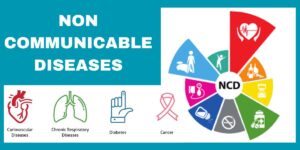- Introduction
- Definition of NCD NHP Gov In
- Importance of NCD NHP Gov In
- Understanding Non-Communicable Diseases (NCDs)
- Types of NCDs
- Prevalence and Impact
- National Health Policy (NHP) Overview
- Objectives of NHP
- Key Strategies in NHP
- The Role of the Government in Health Policy
- Government Initiatives
- Public Health Campaigns
- Key Features of NCD NHP Gov In
- Comprehensive Coverage
- Accessibility and Affordability
- Preventive Measures and Awareness Campaigns
- Health Education Programs
- Screening and Early Detection
- Healthcare Infrastructure and Services
- Hospitals and Clinics
- Mobile Health Units
- Technological Integration in NCD Management
- Use of Digital Health Records
- Telemedicine Services
- Community Engagement and Participation
- Role of NGOs and Community Groups
- Volunteer Programs
- Challenges in Implementing NCD NHP Gov In
- Funding and Resource Allocation
- Cultural and Social Barriers
- Success Stories and Case Studies
- Case Study 1: Diabetes Management in Rural Areas
- Case Study 2: Hypertension Awareness Campaign
- Future Prospects and Innovations
- Emerging Technologies in Healthcare
- Policy Revisions and Updates
- The Global Perspective on NCDs
- Comparison with Other Countries
- International Collaborations
- Personal Responsibility and Lifestyle Changes
- Diet and Nutrition
- Physical Activity and Exercise
- Conclusion
- Recap of Key Points
- Call to Action
Introduction
When we talk about healthcare, one term that often pops up is NCD NHP Gov In. But what exactly does it mean? Well, NCD stands for Non-Communicable Diseases, which include chronic diseases like heart disease, diabetes, and cancer. NHP refers to the National Health Policy, and Gov In indicates government initiatives in India. So, NCD NHP Gov In essentially refers to the Indian government’s policies and initiatives to tackle non-communicable diseases. Understanding this framework is crucial because it plays a significant role in shaping the health and well-being of millions of Indians.
Understanding Non-Communicable Diseases (NCDs)
Non-communicable diseases are those that cannot be passed from person to person. Types of NCDs include cardiovascular diseases, cancers, chronic respiratory diseases, and diabetes. These diseases are largely a result of genetic, physiological, environmental, and behavioral factors.
The prevalence and impact of NCDs are staggering. They account for 60% of all deaths in India, making them a leading cause of mortality. The economic burden is also immense, affecting productivity and causing significant healthcare costs.
National Health Policy (NHP) Overview
The objectives of the National Health Policy are broad but clear. They aim to improve the health status of the population by providing equitable access to quality health services and promoting healthy lifestyles.
Key strategies in NHP include preventive and promotive health, curative health services, and the use of technology to improve health outcomes. The policy also emphasizes strengthening healthcare infrastructure and workforce.
The Role of the Government in Health Policy
The Indian government has launched several initiatives to combat NCDs. These include the National Program for Prevention and Control of Cancer, Diabetes, Cardiovascular Diseases, and Stroke (NPCDCS). Public health campaigns like Ayushman Bharat and Fit India Movement are also pivotal.
Public health campaigns focus on spreading awareness about the importance of regular check-ups, a balanced diet, and physical activity. These campaigns often use mass media and community-based activities to reach a wider audience.
Key Features of NCD NHP Gov In
The policy framework provides comprehensive coverage for NCD prevention and treatment. It includes guidelines for early detection, management, and rehabilitation of patients suffering from these diseases.
Accessibility and affordability are central to NCD NHP Gov In. The government aims to provide free or subsidized treatment for NCDs, particularly for the underprivileged sections of society. This includes the availability of essential medicines and diagnostics at primary healthcare centers.
Preventive Measures and Awareness Campaigns
Health education programs are a cornerstone of NCD prevention. These programs educate people about the risk factors associated with NCDs, such as smoking, unhealthy diets, and physical inactivity.
Screening and early detection initiatives are crucial. Regular health camps and mobile screening units are deployed to detect diseases like diabetes and hypertension at an early stage, which can significantly reduce complications and healthcare costs.
Healthcare Infrastructure and Services
India has been working on enhancing its healthcare infrastructure to manage NCDs effectively. This includes upgrading hospitals and clinics, especially in rural areas, to provide better diagnostic and treatment facilities.
Mobile health units play a vital role in reaching remote and underserved areas. These units offer basic health services, including screening and follow-up care, thus bridging the gap in healthcare access.
Technological Integration in NCD Management
The use of digital health records is transforming NCD management. These records help in maintaining patient history, tracking progress, and ensuring continuity of care. They also facilitate better coordination among healthcare providers.
Telemedicine services have gained prominence, especially in the wake of the COVID-19 pandemic. They allow patients to consult with specialists remotely, reducing the need for travel and minimizing the risk of exposure to infections.
Community Engagement and Participation
NGOs and community groups play a significant role in NCD management. They help in spreading awareness, organizing health camps, and providing support to patients and their families.
Volunteer programs are also essential. Volunteers, including healthcare professionals and students, often participate in awareness campaigns, health screenings, and other community health activities.
Challenges in Implementing NCD NHP Gov In
Despite significant efforts, several challenges remain. Funding and resource allocation are major issues. Ensuring that there is sufficient budget for NCD programs and that resources are utilized efficiently is critical.
Cultural and social barriers also pose challenges. For instance, there may be stigma associated with certain diseases, or people might not prioritize preventive health measures due to lack of awareness or cultural beliefs.

Success Stories and Case Studies
There are numerous success stories that highlight the impact of NCD NHP Gov In. One such example is a case study on diabetes management in rural areas. Through regular screenings and health education, several villages have seen a significant reduction in diabetes cases.
Another inspiring case study is the hypertension awareness campaign. This campaign involved local health workers conducting door-to-door visits, educating people about hypertension, and encouraging them to get regular check-ups. The result was a noticeable decrease in hypertension-related complications.
Future Prospects and Innovations
Looking ahead, emerging technologies in healthcare offer promising solutions for NCD management. Wearable devices, for example, can monitor vital signs and alert patients and doctors to potential issues in real-time.
Policy revisions and updates will also play a crucial role. As new health challenges emerge, policies need to be flexible and responsive to ensure continued progress in managing NCDs.
The Global Perspective on NCDs
When we compare India’s approach with other countries, we find both similarities and differences. Countries like Japan and Finland have implemented successful NCD prevention programs that India can learn from.
International collaborations are also beneficial. By partnering with global health organizations and other countries, India can gain access to additional resources, expertise, and innovative practices.
Personal Responsibility and Lifestyle Changes
At the end of the day, personal responsibility plays a huge role in combating NCDs. Simple lifestyle changes, such as maintaining a balanced diet and nutrition, can make a significant difference.
Physical activity and exercise are equally important. Regular exercise helps in maintaining a healthy weight, reducing the risk of heart disease, and improving overall well-being.
Conclusion
In conclusion, NCD NHP Gov In is a comprehensive initiative that aims to tackle the growing burden of non-communicable diseases in India. By focusing on preventive measures, improving healthcare infrastructure, leveraging technology, and engaging communities, the Indian government is making significant strides in managing these diseases. However, continued efforts and collaboration at all levels are essential to ensure a healthier future for all.
FAQs
- What are non-communicable diseases (NCDs)? Non-communicable diseases are chronic diseases that are not transmitted from person to person. Examples include heart disease, diabetes, and cancer.
- What is the National Health Policy (NHP)? The National Health Policy is a framework set by the Indian government to improve the health status of the population through various strategies and initiatives.
- How does the government support NCD management? The government supports NCD management through initiatives like the NPCDCS, public health campaigns, and providing accessible and affordable healthcare services.
- What role do NGOs play in NCD management? NGOs help in spreading awareness, organizing health camps, and providing support to patients and their families, thus playing a crucial role in NCD management.
- Why is early detection important in managing NCDs? Early detection allows for timely intervention, which can prevent complications, reduce treatment costs, and improve patient outcomes.



